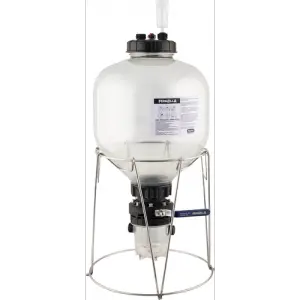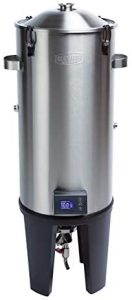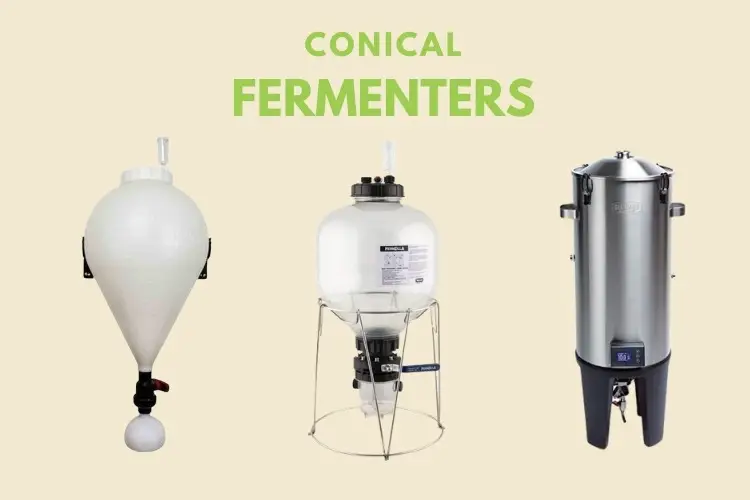How to choose the right fermenter is a decision not to take lightly. Sure, to ferment beer, any container will work; even a cheap plastic carboy and a 6.5-gallon plastic bucket will do. The devil’s in the details, though, and although you can ferment beer in any container, making high-quality beer is another story.
A conical fermenter is not a necessity for homebrewers but it can be a good upgrade from the classical bucket or carboy. With a conical fermenter, there is no need of racking the beer in another vessel and spent yeast can be captured easily for future batches. But they can be expensive, uneasy to manipulate or to fit in a fermentation fridge.
What You Should Look For in a Fermenter
Making beer has its unique learning curve, and we’ve all been there.
What you want in a fermentation vessel is three things:
- Ideally, a stable, cold temperature. Average ale fermentation temperatures range from 64 to 72 °F (18 to 22 °C), and lagers need even colder temperatures, from 45 to 55 °F (7 to 13 °C).
- You also need your fermenting beer to remain undisturbed. Yeasts are pretty moody, and they like to be left alone as they work.
- The ability to, one, remove the sediment and dead yeast from the bottom of the tank, and two, drain the beer undisturbed to be bottled or conditioned. Here’s where the conical fermenter comes in.
Benefits of a Conical Fermenter
✔️ The conical fermenter will use gravity to capture the beer’s sediment and spent yeasts in the bottom where you’ll usually find a dump valve or a sediment collector. Very useful to able to remove the trub and hop residue that easily.
You can even reuse the yeast for future batches or discard it altogether.
✔️ These fermenters will also allow you to hose the beer for bottling or conditioning without needing to siphon it.
They’ll protect the beer from unnecessary contact with oxygen in the process, therefore from oxidation. There’s less risk of bacterial contamination as well.
✔️ A conical fermenter will also let you to carry out the primary and secondary fermentation in the same vessel, saving you time and effort while protecting your beer.
With secondary fermentation, we mean transferring or racking your finished beer to a second vessel to separate it from the sediments — the objective? Clearer beer.
You don’t have to fret about that with a conical fermenter.
✔️ With some models, you can ferment under pressure.
✔️ It comes without saying cleaning and sanitizing a conical fermenter is as easy as it gets as long as the opening is large enough. You don’t have to worry about corners, nooks and crannies, where bacteria love to hang out, and where sediment from previous brews undoubtedly sticks around.
Cons of buying a Conical Fermenter
If there are any downsides about getting a conical fermenter is that you must buy it separately. Few or no starter kits come with this type of vessel.
❌ Since they’re much more complex than a regular glass carboy or plastic bucket, expect to pay a bit more.
❌ Keep in mind not all conical fermenters come with their stand; they might include a wall-mount but not a floor stand or the other way around, so make sure you have a way to incorporate the conical fermenter into your set-up and available space.
❌ Plastic conical fermenters can scratch easily, which allows bacteria to hide from the sanitizer wash, meaning you will have to replace it often if you want to avoid risking ruining your beer.
❌ Stainless-steel conical fermenters can be pretty sophisticated but expensive. They might include built-in insulation, temperature-controlled systems, different sediment racks and compatibility with more advanced equipment like chillers or bottling equipment. You pay extra for every feature.
❌ Not all conical fermenters will fit in a fridge or temperature-controlled fermentation chamber, and that might be a big deal if you’re used to this brewing method — particularly useful for brewing lagers or if you live in warmer climates.
❌ The process of dry-hopping your beer is more popular than ever, and it might be tricky if using a conical fermenter. The fermenter’s opening can be pretty narrow, and you might find it difficult to throw in a steeping bag filled with hops.
❌ Might require more expenses like the matching stand or with fermentation done under pressure. CO2 tank, regulator, and other pieces needed to use gas pressure all come with a price.
❌ Conical fermenters, in general, can be a pain to handle. Wall-mounted fermenters are not practical at all, and they often lack handles, so moving them around can be tricky because they can be quite heavy. A conical vessel is not very steady, as you can figure.
Can you bottle from a conical fermenter?
You can easily bottle your beer straight from a conical fermenter by simply attaching a hose to the bottom valve. If the flow is not steady, you might need to lift your fermenter a few feet, but that’s not always necessary.
Some home-brewers, though, prefer to transfer their beer from their conical fermenter to another bucket before bottling to prime the beer with corn sugar, table sugar or dry malt extract.
The sugar is just easier to add and dissolve in a more accessible container.
Should You Get a Conical Fermenter? The Bottom Line.
Whether you’re just getting started in the exciting world of craft brewing or you have some experience under your belt, a conical fermenter might be perfect for you, but then again, they’re not one-size-fits-all.
Some people are thrilled with non-conical fermenters, and most brewers have shared that they don’t find a significant difference in the beer’s quality.
Conical fermenters aren’t necessarily expensive, so they might be worth trying out.
Having said that, If you bought a starter kit, play around with the included fermenter to make your first batches, and assess if you need a fermenter of different size, capacity or shape. You can keep your brewing set as straightforward or as sophisticated as you want.
If you do decide to get a conical fermenter, you might want to see the plastic fermenters available. The next step would be upgrading your plastic fermenter to a stainless-steel conical fermenter. If it has an integrated thermometer and a temperature control system, even better. Make sure it comes with legs attached, welded handles and perhaps a glass lid and a sophisticated airlock.
Please don’t say we didn’t warn you. Once you start collecting brewing equipment, you never stop, and it doesn’t matter how fancy your fermenter is; you’ll eventually want a larger, better one, but that’s part of the fun!
Popular Conical Fermenters
Here are some conical fermenters to get you started on your quest to find the perfect one for you. Keep in mind that you might need more sophisticated features depending on your ambitions and experience level.
An uncomplicated plastic conical fermenter is ideal for home brewing amateurs, while others will satisfy even the most seasoned brewer.
Fastferment Conical Fermenter
No products found.
This 7.9 Gallon homebrew kit includes a BPA-free plastic fermenter with an included wall-mount and detachable sediment collector. With an overall high-quality and an available insulation jacket (sold separately), this is a nice piece of equipment.
FermZilla Conical Fermenter

This 7.1-gallon plastic fermenter is one of the best-known in the market. Its large butterfly dump valve is a highlight, and so is its large 4.75-inch opening (that makes it easy to clean and allows for easy dry-hopping). The three-piece airlock is super-efficient, and the adhesive thermometer is a nice touch.
Grainfather Conical Fermenter

This stainless-steel fermenter with double-wall insulation and built-in cooling sleeve allows for programmable controlled temperature with minimal oxygen exposure. This beauty comes with a hefty price tag, though, so shop wisely.
Last update on 2024-10-03 / Affiliate links / Images from Amazon Product Advertising API

